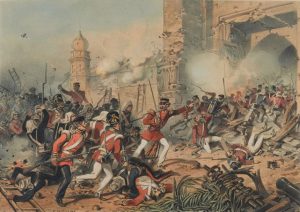What is the similarity between British retribution after recapturing Delhi from mutineers in 1857 and the Israeli state’s raging military operation in Gaza today? The two incidents may be separated by 165 years of history, but there are some very visible parallels.
The revolt, in which sepoys temporarily freed Delhi from British rule in May 1857, was an unprecedented British military and intelligence failure. The mutiny that started in Meerut soon captured the imagination of many big and small kingdoms in North India, which decided to join the revolt. It was by no means an unprovoked attack, as many British officials at the time would have wanted the world to believe. In their hundred-year rule over India, the British had violated all that Indians held dear and sacred. The revolt was a violent but understandable response to a century of subjugation, humiliation, and dehumanization.
One incident that stood out for its cruelty was the massacre of 150 British people, including non-combatants, women, and children, at Kanpur. In her paper titled “Satan Let Loose upon Earth,” Rudrangshu Mukherjee noted that the sepoys initially offered the British safe passage. However, after being loaded onto boats at a nearby Ghat, they were indiscriminately fired upon.
Fast forward to October 7, 2023, when an unprecedented series of events unfolded as the world awoke to the news of Hamas militants capturing some areas near the Gaza-Israel border, albeit for only a few hours. These attacks, in addition to their unprecedented nature, carried significant symbolic weight. Palestinian militants took control of checkpoints and settlements, and even bulldozed sections of the apartheid wall, all of which had come to symbolize the half-century-long Israeli occupation.
The October 7 attack was undoubtedly violent, but, like the Revolt of 1857, was not without provocation. There is a very dense background of Israeli settler colonialism and state violence that is inseparable from the response. All that the Palestinians hold dear, from the great Al-Aqsa Mosque to their olive groves, has seen repeated sacrilege at the hands of Israeli forces and settlers.
In both instances, however, the tables soon turned.
After liberating a few territories from the clutches of the British, the sepoy mutiny soon lost steam. Reinforcements arrived from Punjab and expelled the mutineers from Delhi. By this time, the story of the Kanpur massacre had not only spread from India to Europe, but many layers of exaggeration had been added to them. Unsubstantiated stories about children being nailed to walls and mass rapes of British women started doing the rounds. These stories played a huge role in tailoring the public opinion in England in favor of an uninhibited use of force against the “savage natives.” When the time came to punish the mutineers, British soldiers and the media used these rumors not only to justify excessive the use of force and widespread retribution, but also to demand the complete destruction of Delhi.
In the Lahore Chronicle, for example, British writers called repeatedly for the hanging of the Sultan and the “leveling” of his city. One reader in a response piece in the Chronicle demanded, “no sparing the Jama Masjid for the fear of offending the Moslem.” There were also suggestions of turning the Jama Masjid into a church. These writings, suggestions, and demands struck a chord among the British troops in Delhi. Even after widespread looting and mass murder of adult males in Delhi, demands for the complete destruction of the city continued to be raised. Mass murder tantamount to genocide was thus justified on the basis of manufactured falsehoods.
Similar unsubstantiated exaggerations made their way into the public domain soon after the Hamas attack on Israel. The famous story about the “40 beheaded babies” originated from reporter Nicole Zedeck’s interview with an Israeli reserve soldier. Similar claims were soon echoed by the Israeli prime minister and the U.S. president, causing immense outrage throughout the world. A couple of days later, Zedeck retracted the report as no evidence to confirm the beheadings could be found. By then, however, the story had been widely published in international media and had tailored a public opinion in favor of massive retaliatory action in Gaza.
Genocidal demands to “raze Gaza to the ground” emerged from various quarters, enjoying support from Israel’s defense forces. These demands were often infused with a heavy dose of religious and racist rhetoric that tried to portray Israelis as “children of light” and Palestinians as “children of darkness.”
Israeli operations in Gaza have so far included bombings of hospitals, residential buildings, universities, refugee camps, and border crossings in addition to the cutting of Gaza’s water, gas, and electricity supply. More than 10,000 people had been killed in the Israeli military’s relentless bombings of Gaza at the time of writing, many of them children. But the demands for “razing Gaza to the ground” continue to be made.
These operations – which are war crimes, even if we go by the narrowest definition of the term – are retributions that are justified on the basis of unsubstantiated claims of Palestinian militants beheading children and raping women. The Hamas attack on October 7 was extremely violent but these layers of exaggeration that were added to the narrative surrounding the attack helped create a monstrous image of all Palestinians, which now makes the bombing of their homes and schools seem like less of a tragedy.
If there is one thing that a comparison between British retribution in 1857 and Israel’s supposedly retaliatory measures in 2023 tells us, it is the fact that the colonial playbook has remained more or less unchanged. On one hand, there is a refusal to acknowledge indirect colonial violence, which manifests itself in the form of discriminatory laws, apartheid walls, settlements, and checkpoints. On the other, direct colonial violence is justified by dehumanizing the native and creating the image of “human animals,” who can only be reined in with immense and indiscriminate violence.

































